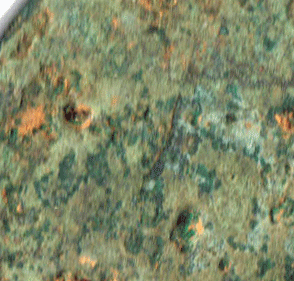Anxious to find something before the day was out, we headed over to an old faithful spot, a field which used to contain a building along the old roadbed of Saxapahaw Bethlehem Church Rd.. Regular readers may recall some of the better finds from the area, including colonial flat buttons, a Revolutionary War era musket trigger guard, and a very nice script letter Bingham School uniform button. Although finds from this site have slowed, it still produced one excellent keeper for me.
This copper alloy piece is known as a bit boss or bridle boss, a decorative piece used on a horse bit. It would have had two attachment holes on tabs at the top and bottom, and worn as a pair on either side of a curb style bit. Below are several images showing the use of a bit boss. The illustration on the left shows a curb style bit, with red circles indicating where the bit bosses attach. The central bar goes in the horse's mouth, and the loops attach to the reins which allow the rider to control the horse. The central image is taken from an early 17th century illustration, showing a horse with an ornate bit boss. On the right is a fancy modern curb bit in silver, with a gold bit boss, based on 17th century Portuguese designs. The Union Army used a bit boss imprinted with the letters "US" which is high on my wish list.
This particular bit boss likely dates from the mid 1700's to early 1800's. It seems to be made from a copper alloy similar to tombac, as shown by the fragmentation where the piece is broken, as well as the relatively low conductivity. Air tests show a 50 on the White's VDI scale, which is much lower than expected for a typical brass piece of this size. I have previously found several other pieces of horse tack along different parts of the old Sax Beth road bed. The copper disc below is known as a bridle rosette, another decorative bridle accessory. The straight bar across the back of the rosette attaches it to the bridle above the horse's temple. I have also included an image of a bridle rosette in use for demonstration purposes. Because of the very basic design of this copper rosette, it is very difficult to estimate its age.
My favorite rosette came from a mid-1800's house near Saxpahaw. This rosette has a brass back (the attachment bar is missing) which was once gold-plated. The front of the rosette is a flat-topped glass dome. Vibrantly colored pictures were placed inside, allowing it to be seen through the glass top, with common themes including horses, dogs, and flowers. The orange/red color is water damage from many years below the ground, but some of the original pink flower and leaves can still be seen. This type of rosette was particularly popular from about 1870 to just after the turn of the century. You can see a non-dug example of a floral themed glass rosette here.
This larger piece was recovered at the Buckner century farm on Sax Beth Ch. Rd. It has a brass front and lead back, with a channel to attach to a strap of some kind. I have always assumed this to be another piece of decorative horse tack similar to a rosette, but I'm not sure exactly what it is. If you have any idea, please let me know in the comments below!
Finally, I will leave you with an update on the coin I found on Thursday. I was able to find just one piece of detail remaining on the coin, but it was enough to narrow it down considerably. The line of the nose and forehead of Lady Liberty is still present, which indicates a leftward facing bust. This can only be the matron head large cent (1816-1839), as previous large cents had a rightward facing bust. I have provided a gif image below the fold, which shows an overlay of my coin and the matron head large cent, confirming this hypothesis. It's not the easiest to see, but concentrate on the bridge of the nose.
I apologize for the extremely long-winded blog post - I tend to get carried away sometimes! But I hope you enjoyed reading, or at least looking at the pictures. Until next time, thanks for stopping by, and God bless!
Finally, I will leave you with an update on the coin I found on Thursday. I was able to find just one piece of detail remaining on the coin, but it was enough to narrow it down considerably. The line of the nose and forehead of Lady Liberty is still present, which indicates a leftward facing bust. This can only be the matron head large cent (1816-1839), as previous large cents had a rightward facing bust. I have provided a gif image below the fold, which shows an overlay of my coin and the matron head large cent, confirming this hypothesis. It's not the easiest to see, but concentrate on the bridge of the nose.
I apologize for the extremely long-winded blog post - I tend to get carried away sometimes! But I hope you enjoyed reading, or at least looking at the pictures. Until next time, thanks for stopping by, and God bless!








Love the morphing large cent GIF!
ReplyDeleteYour Buckner find is not horse related. The square slot in the back indicates that it's a pendulum from a clock.
ReplyDelete